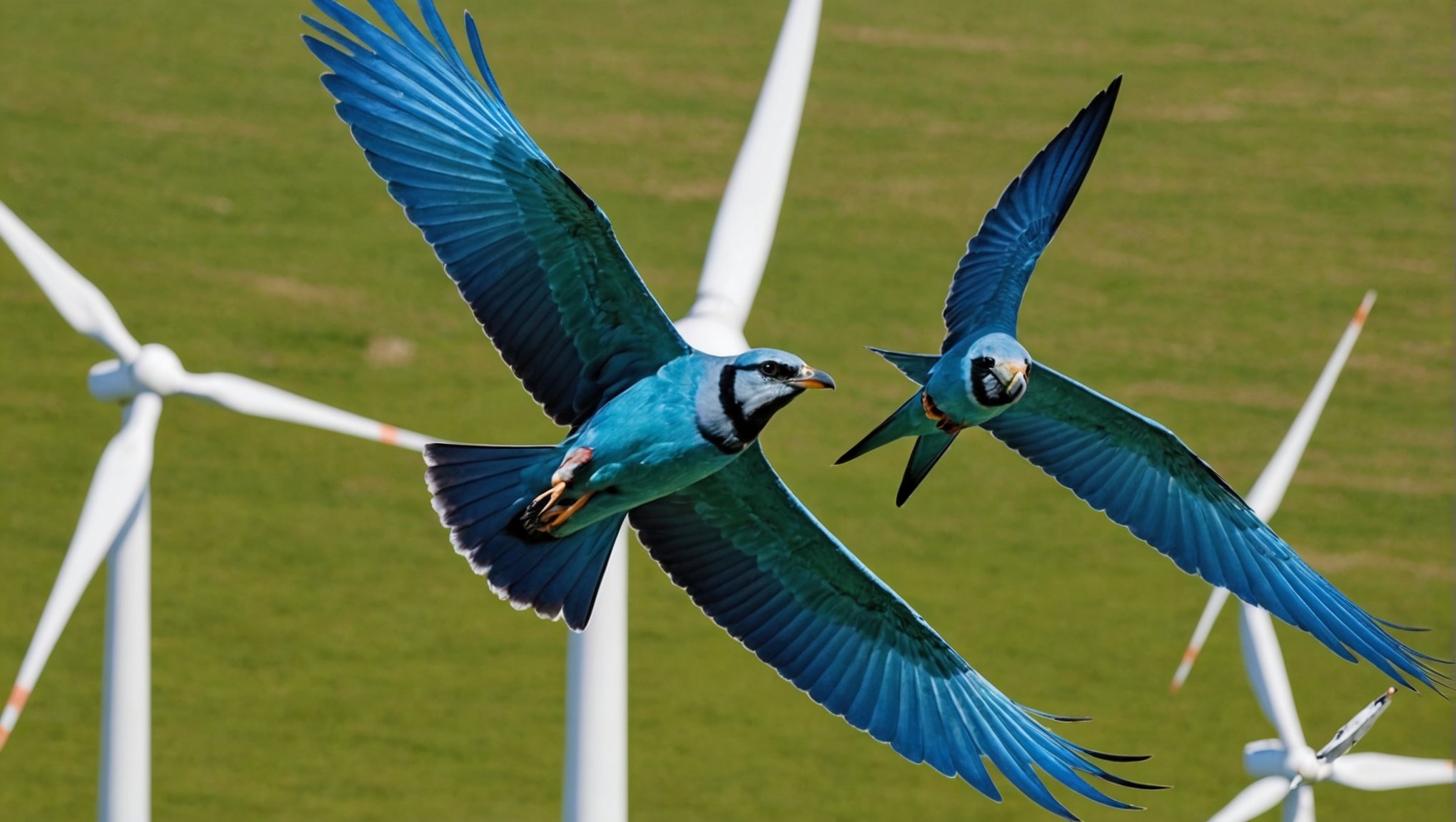Overview of Bird Strikes at Wind Farms
Bird strikes at wind farms are an environmental impact concern, garnering attention from conservationists and energy developers alike. Their occurrence is linked to the growing deployment of wind farms worldwide. Wind turbines, notable for their towering structures and rotating blades, pose a threat to avian species, particularly in migratory paths and bird-rich habitats.
Several factors contribute to bird strikes. The location of wind farms is crucial; those situated along migration routes or near nesting areas inherently have a higher risk of bird collisions. Additionally, the height and speed of turbine blades can disorient birds, leading to fatal encounters.
A découvrir également : Guardians of the Glen: Explore Key Initiatives to Save the Scottish Wildcat from Extinction
Addressing bird strikes is essential for advancing sustainable renewable energy. Implementing mitigation strategies not only protects bird populations but also balances ecological concerns with energy needs. Effective solutions include adjusting turbine placement, enhancing turbine visibility for birds, and employing technology such as radar systems. Such initiatives underscore renewable energy’s commitment to reducing its environmental impact while maintaining ecological harmony.
Factors Contributing to Bird Strikes
Understanding why bird strikes occur can guide thoughtful development strategies in wind farm planning and management. By considering ecological factors and employing modern innovations, the impact of wind farms on birds can be minimized, fostering coexistence between energy infrastructure and wildlife.
Cela peut vous intéresser : Essential Tips for UK Residents: How to Build the Perfect Bat Boxes in Your Local Area
Innovative Research Initiatives in the UK
Innovative research efforts in the UK have led to significant advancements in bird strike prevention, with several innovative projects at the forefront.
Overview of Key Research Projects
In the UK, key research projects aim to develop cutting-edge solutions for bird strike prevention. Technological advancements, such as radar systems and AI-driven detection, have been explored to reduce bird strike incidents. These initiatives not only enhance aviation safety but also contribute to bird conservation efforts.
Collaboration between Universities and Industry
Collaboration between universities, industry experts, and multidisciplinary teams is essential. Ecologists, engineers, and policymakers work together to create holistic solutions for bird strike prevention. This interdisciplinary approach results in a deeper understanding of bird behaviour and flight patterns, leading to more effective strategies.
Funding and Support for Research Initiatives
Funding and support from both governmental and private sectors play a crucial role. Various sources, including governmental grants and private investments, provide essential resources to drive research forward. These funds enable the development and implementation of innovative technologies, ensuring sustained progress in bird strike prevention efforts. This combined support enhances the UK’s position as a leader in aviation safety and bird conservation.
Cutting-Edge Solutions Being Developed
In the race to safeguard avian species while harnessing renewable wind energy, bird monitoring technology stands at the forefront. This advanced technology employs high-resolution cameras and radar systems to detect bird presence around wind farms. By continuously tracking avian movement, these systems provide real-time data crucial for minimizing bird collisions with turbines.
Innovative deterrent systems are being tested to further protect wildlife. These modern solutions include acoustic deterrents that emit frequencies unpleasant to birds but inaudible to humans. The objective is to gently guide birds away from danger zones without causing harm. Light-based systems are also being explored, using patterns and flashes to alert and steer birds clear of turbine blades.
Complementing these technologies are robust wildlife management practices. This involves habitat management to ensure birds have alternative safe zones away from wind farm areas. Additionally, periodic assessments are conducted to optimize strategies and ensure effectiveness. With a harmonious blend of both technology and careful ecological management, the aim is to create an environment where renewable energy and wildlife thrive side by side. By staying at the cutting edge of innovation, these strategies promise a balanced approach to sustainable energy development.
Case Studies of Successful Implementations
Examining well-documented case studies reveals success stories filled with valuable best practices. Each example below illustrates different approaches and outcomes, providing a comprehensive understanding of effective strategies.
Example 1: Effective Deterrents in Action
Bird strikes have long posed significant challenges, but some locations have successfully addressed this issue using deterrent systems. In one notable case, adopting state-of-the-art bird detection technology dramatically lowered the incident rate. The system relied on advanced sensors and real-time alerts to prevent birds from entering hazardous zones. Such measures highlight how targeted deterrents can enhance safety.
Example 2: Collaborative Approaches and Lessons Learned
Collaborative projects have emerged as potent tools in mitigating bird strike risks. One project gathered environmental experts, engineers, and aviation authorities to share insights and develop integrated strategies. This collective effort not only improved communication but also optimized resource allocation, resulting in more efficient deterrent systems. The lessons learned from these partnerships emphasize the power of teamwork.
Example 3: Impact Assessment and Future Directions
Recent impact assessments underscore the importance of continuous innovation. Data from successful implementations informs future strategies, helping to refine current methods and anticipate new threats. This forward-thinking approach fosters adaptability, ensuring that deterrent systems remain effective and responsive to ever-evolving challenges. These insights aid in crafting robust plans for the horizons yet to come.
Environmental and Ecological Implications
Understanding the broader ecological impact of bird strikes is crucial as it affects avian populations significantly. These impacts are far-reaching, disturbing not only individual bird species but also interconnected ecosystems. Bird strikes result in avian fatalities, which can upset ecological balance, especially when affected species play key roles in their habitats.
To mitigate these effects, implementing effective strategies is essential. Mitigation efforts, such as modifying structures and employing avian radar technologies, align with wildlife conservation objectives. By reducing fatal encounters, they help preserve biodiversity and protect avian species that are vital for ecological health.
Renewable energy benefits offer an additional layer of support for environmental sustainability. For instance, solar and wind power present cleaner alternatives to fossil fuels, decreasing pollution and habitat destruction. Additionally, innovative designs in renewable energy infrastructure, like bird-safe wind turbines or solar panels, enhance compatibility with wildlife conservation. These advancements ensure that while we transition towards sustainable energy solutions, we can concurrently uphold our obligations towards preserving ecosystems.
In essence, balancing energy needs with ecological responsibilities is feasible. It requires a unified approach prioritising both energy innovation and robust conservation practices. This dual focus fosters a healthier coexistence between human activity and wildlife, promoting environmental sustainability for all life forms.
Interviews and Insights from Researchers
In the realm of bird strike mitigation, researcher insights are invaluable. Dr. Emily Morrison, a leading authority in the field, emphasises the impact of bird strikes on aviation safety. She notes, “Minimising bird strikes requires a multifaceted approach, from technological advancements to habitat management.” Her expert opinions highlight the necessity of collaboration among stakeholders, including airport authorities and environmental agencies.
Fieldwork experiences illustrate the challenges researchers face. Dr. Liam O’Connell describes the difficulty in predicting bird movement near airports. He explains, “Understanding bird behaviour is complex due to environmental variability.” Such unpredictability often complicates both research and the implementation of mitigation strategies. Expert opinions continuously stress the need for adaptive solutions tailored to specific airport environments.
Looking to the future, there’s a consensus on the importance of emerging technologies. Innovations like radar systems that identify bird activity in real-time are gaining momentum. The ongoing research trends suggest that integrating these technologies with traditional measures could significantly reduce incidences. Researchers are optimistic that with sustained investment and interdisciplinary cooperation, the vision of safer skies can be achieved.











